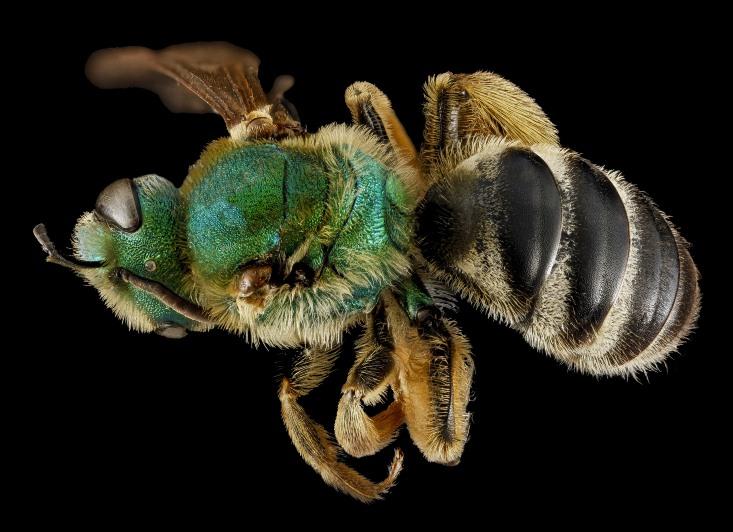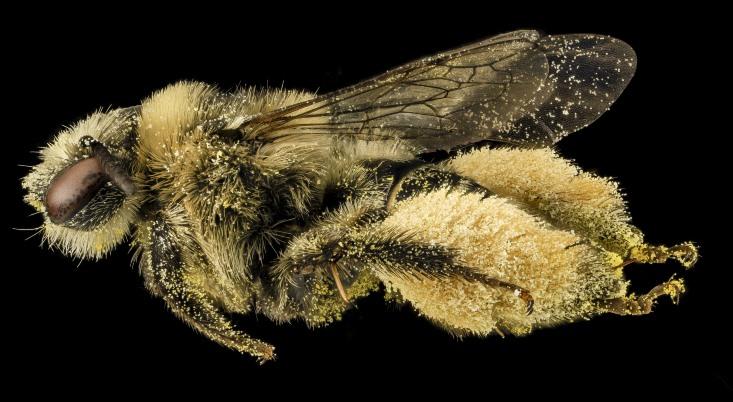All of the images in this post are borrowed from the amazing Flickr feed of the USGS Bee Inventory and Monitoring Lab.

Any day now, the apple trees on my deck will bloom, bringing with them the first honeybees of spring. It’s a moment I’ll greet with mixed feelings. To which bee-lovers everywhere may respond: How can anyone feel anything but good about honeybees? They’re little gold-and-black life-bringers, booty-waggling symbols of industrious virtue, and now—after a decade of declines in commercial honeybee colonies—subjects of sympathy and concern. We all want to help the bees.
All of which is true, and honeybees are certainly not unwelcome guests. And yet: Most of them will be domesticated, belonging to colonies maintained by New York City’s urban beekeepers. They’re also competing for the same blossoms with wild bees. Indeed, urban honeybees have the potential to push out their wild brethren. “If you have lots of honeybees,” says Dave Goulson, an insect ecologist at the University of Sussex, “it is bad for wild bees.”

That bees other than honeybees and bumblebees even exist is a fact many people don’t appreciate. I didn’t until several years ago, when I stumbled across the extraordinary photography of Sam Droege. An entomologist with the United States Geological Survey, Droege literally revealed a new world to me: bees large and small, not just black and yellow but red and green and blue, an evolutionary jewel box of pollinators.
There are more than 4,000 native bee species in the U.S., many of them threatened and diminishing in number—a decline rather less remarked-upon than the honeybee problems. Yet these wild bees also play a vital role in pollinating crops and the landscape writ large, in both the country and in cities. There are some 200 wild bee species in New York City alone, and soon I started noticing them: leafcutters with pollen-doused foreheads, rice grain-sized masked bees and my favorite of all, the emerald-bodied virescent sweat bee.

Most of these wild bees are solitary, living alone or in small groups. They’re not social like honeybees, who live in large colonies and, thanks to their marvelous communicative abilities, can descend en masse within minutes of a single bee finding a flower patch. Neither are they so aggressive as honeybees. Part of the reason native bees go unnoticed is that they’re so unlikely to sting anyone (though sweat bees are indeed drawn to perspiration; after encountering Droege, I noticed that what I’d thought were flies chasing me on jogs were actually bees).
These gentle loners, then, can easily be pushed to the side by honeybees, and much research describes how a large honeybee presence can exclude the natives. An unsettled question, though, is whether this is existentially bad or just inconvenient: Do native bees run out of food and decline in number, perhaps disappearing from the area altogether, or simply find another flower patch?*

It’s a difficult question to study in a methodologically precise manner, says Rachael Winfree, a pollinator ecologist at Rutgers University, but the crux is the availability of flowers. In suburban New Jersey, where Winfree works, there are plenty of blooms to go around. In other situations, though, such as urban areas with relatively few blooms early in spring or late in summer, floral bottlenecks may occur, with honeybees crowding out natives in a push for scarce resources.
Native populations can decline and, along with them, the pollination they provide to plants that go unvisited by honeybees or are not particularly well-pollinated by them. These include a cornucopia of crops, including tomatoes and blueberries and squash, and a kaleidoscope of wildflowers and shrubs and trees. A locale without wild bees is a far less verdant place.

To be sure, this isn’t reason to condemn urban beekeeping, which is often pursued by people trying to enrich their pocket of the world, rather than their own pockets, and provides a connection to nature that might not otherwise exist. And it’s likely only a problem when a few dozen hives are concentrated in a relatively small area. A hobbyist’s single backyard hive isn’t as much of an issue.
Still, these conflicts do underscore that our honeybees don’t exist in a vacuum. They’re part of an ecology, sharing a neighborhood with other nectar-loving residents. To keep honeybee hives without paying any mind to bees already present, as with fashionable airport beehives that seem to be installed under the premise that untended green spaces are empty rather than teeming with life, runs contrary to the spirit of beekeeping.
Diane Thomson, a Claremont McKenna College ecologist who has studied interactions between honeybees and bumblebees, offers a compromise: Treat urban honeybees as a window into a wider world. In caring for and about them, care for wild bees, too. Plant pollinator-friendly native flowers, protect their habitat from overzealous landscapers, build places for them to nest, and tell other people about them. After all, the greatest native bee threat isn’t honeybees, but people who don’t think about nature.

Brandon Keim is a freelance journalist who writes about science, technology, and nature. His work has appeared in Wired, Aeon, Scientific American Mind, and other publications.
*As originally published, this post included a photo of Helophilus fasciatus, a hoverfly. It is similar in appearance to a bee, but is not, in fact, a bee.


























